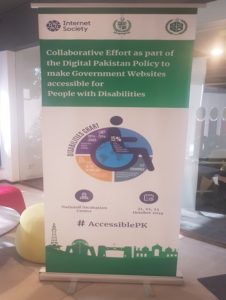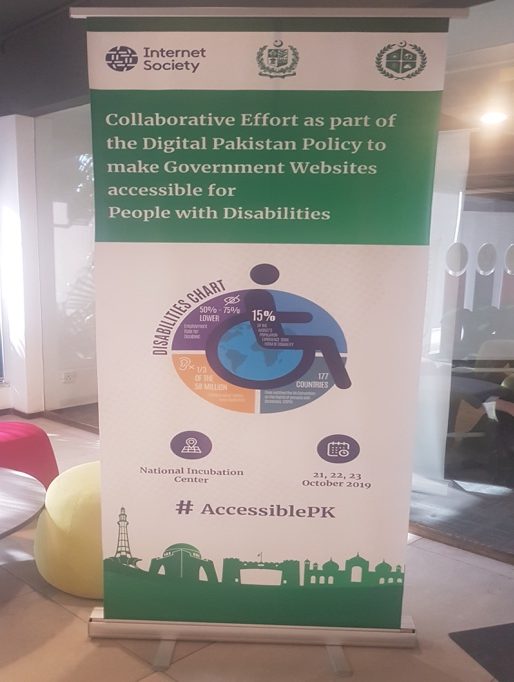By Muhammad Shabbir Awan
The 2018 Pakistan IT Policy titled Digital Pakistan envisions “to become a strategic enabler for an accelerated digitization eco system to expand the knowledge based economy and spur socio economic growth”. We felt that with 10-15 percent of country’s population consisting of Persons With Disabilities (PWDs) and over 95 percent of inaccessible websites, this vision would remain just rhetoric unless we do something about it. The answer, “make websites accessible for PWDs” seems easier said than done. Nonetheless, I am pleased to report that we have taken another significant step towards making ‘Digital Pakistan’ inclusive and accessible for everyone including PWDs.
The Internet Society Asia Pacific Bureau, supported by the ISOC Accessibility Special Interest Group (Accessibility-SIG) and Islamabad Chapter organized a 3-days advanced training on web accessibility from 21st to 23rd October 2019. For this purpose, internationally reputed expert on web accessibility David Berman was invited to organize the training.

Government departments, particularly Ministry of IT, National IT Board and National Incubation Center, were incremental in organizing this event. About 50 webmasters a majority from the government, people with disabilities, and private sectors participated in the training.
The three-days extensive program covered a variety of topics related to digital accessibility that included but was not limited to: introduction to accessibility; why and how accessibility helps everyone and not just those with disabilities; how accessibility will help project budgets; what are the major disabilities and challenges, how most of us have some level of difficulty that can be assisted by accessible design, and assistive technologies we can typically use to mitigate these issues; national and international policy and legislation; overview of W3C WCAG 2 guidelines A and AA levels; PDF and accessible documents overview, including accessible tags; understanding of how enterprise-wide development processes can save money and time; Javascript accessibility; testing tools for Web pages and documents; accessibility checklists; auditing models for page frameworks and specific pages; case studies walkthrough, including existing government websites; and advanced issues that are beyond AA, application and beyond Web and documents.

The purpose of the training was three-fold: first, train the developers to make the websites accessible for PWDs and according to Web Content Accessibility Guidelines 2.1 standards. Second, to prepare local team of developers that is well versed in digital accessibility standards. Third, gather digital experts from Government, private sector and PWDs under one roof to start discussing to find practicable solutions to accessibility-related challenges in Pakistan.

To recall, over the past 4 years the Internet Society has been working on Digital Accessibility issues in Pakistan. This work has resulted in involvement, success and support from the government and local community, including People with Disabilities, to address the digital accessibility challenges in the country. One of the key successful outcomes of our efforts was the Ministry of IT taking PWDs on board as a stakeholder while formulating the aforementioned Digital Pakistan policy that was announced in 2018. With this training we wanted to build capacity of the government webmasters to develop accessible websites. In the concluding session of the training, Member IT of the Ministry of IT, Syed Junaid Imam, who was invited as keynote speaker reassured that all the government of Pakistan websites would be made accessible. He also informed the audience that MOIT is developing the strategy to implement the national IT policy and this time too, the input from people with disabilities will be incorporated in the document.

The cases of Digital Pakistan policy and the current training on one hand show that Pakistan is incrementally moving to make internet truly for everyone, and on the other, proves that solutions to the digital accessibility related issues for PWDs can only be found with their own involvement. Meaning, nothing about us without us! Moreover, now when with the help of civil society the government of Pakistan has formulated the guidelines, the training has been provided to the webmasters, the next step is to translate the rhetoric (policy guidelines) into action! The ISOC Accessibility-SIG is ready to support in whatever way it can. I am sure that together we can ensure the websites not only of the government but also of the private sector are accessible for PWDs. Accessible internet for PWDs would bring us another step closer to fulfilling the objective of leaving no one behind by 2030.
About the author: Muhammad Shabbir Awan is a researcher, a rights activist and the President of Internet Society Accessibility SIG. He tweets at @MshabirAwan


